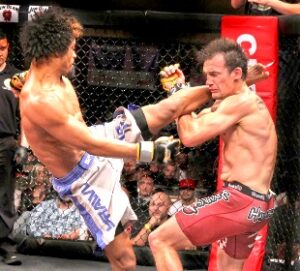Are you wondering about the best martial arts for self-defense no matter where you are?
In this article, we’ll look at the 7 best martial arts for self-defense and the reasons why they’re so effective.
Contents
Best Martial Arts for Self-defense
The best martial arts for self-defense in terms of a 1vs1 (one versus one) fight are grappling-based. This is because you can escape from strikes by running away, but if an aggressor grabs you, you’re now engaged in grappling and need the ability to defend yourself.
If you’re outnumbered, the dynamic has changed and a striking-based martial art is best. However, the best form of self-defense is to avoid fighting at all costs. This can be achieved by being aware of dangerous situations forming, verbal de-escalation, and running.
If there’s no way to avoid a fight because someone is coming at you aggressively, here are the 7 best martial arts for self-defense in a 1vs1 situation.
1. MMA
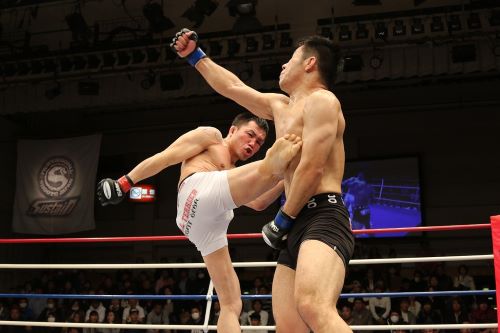
MMA is one of the newer martial arts, made popular by the UFCs founding in 1993.
Mixed martial arts (MMA) focuses on striking, grappling, and Bjj (Brazilian jiu-jitsu), and is the best martial art for self-defense for the following reasons.
1. MMA incorporates a variety of martial art styles
This variety creates well-rounded fighters capable of defending themselves in any direction a fight goes. They can use the following both offensively and defensively: throw a huge variety of strikes, perform takedowns and standing grapple, ground grapple, and use submissions.
Knowing how to do all of this is essentially all anyone ever needs for a fight against a professional fighter of the same skill level, let alone in a self-defense situation against an untrained aggressor.
2. MMA is sport-based and highly competitive
This competition sees practitioners spar often, which is the ultimate form of pressure testing and improving skills under stress. This is essential training for real-life fights in order to be confident and avoid hesitation or freezing.
3. MMA requires elite endurance
As MMA incorporates multiple styles, it trains athletes to be incredibly fit and requires them to improve aerobically and anaerobically; meaning they can repeatedly fight in short explosive bursts of maximal effort and for long durations at a slower pace.
The kind of fitness and cardiovascular endurance MMA requires is extremely effective in self-defense situations.
4. MMA uses small gloves
MMA also has the edge over many other martial arts because the gloves are lighter and smaller, and therefore more relevant to self-defense scenarios that are fought without gloves.
5. MMA is the fastest-growing combat sport in the world
Because of this, there’s a lot of money on the line for MMA fighters. This increases the number of people training in MMA, its competitiveness, the level of coaching, and everything else associated.
Essentially, a rising tide (money) lifts all boats (everything MMA), and MMA fighters are becoming the most skilled in the world because of it. This translates to its effectiveness for self-defense.
Overall, MMA is the king of self-defense because it covers and provides the most skills relevant to a street fight or self-defense situation. It provides all the same benefits of the martial arts below, except not incorporating some useful illegal strikes such as headbutts, groin strikes, and eye pokes.
However, self-defense is about avoiding damage and controlling or neutralizing an aggressor, rather than making them go blind – and MMA more than readies practitioners to do so.
Weaknesses
MMA requires the most skill as it incorporates a huge variety of martial arts. Because of this, becoming proficient takes longer than any other martial art on this list.
2. BJJ
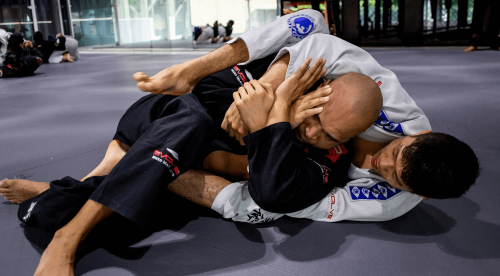
Brazilian Jiu-jitsu (Bjj) focuses on ground fighting by way of grappling and submissions (joint locks and chokes), and some schools also teach takedown offense and defense (necessary for self-defense).
Bjj is an effective martial art for self-defense because it’s grappling-based, and for other following reasons.
1. Highly effective against all martial arts
Bjj has proven many times over to be effective when used by the most elite martial artists in the world against one another, and against elite martial artists from other disciplines – let alone against untrained aggressors in a street fight.
2. Offensive and defensive takedowns
If grabbed by an aggressor, Bjj teaches how to defend against being taken down, as well as how to take them down. Defending takedowns is done with sprawls, hand fighting, breaking grips, and standing submissions such as a guillotine, collar choke, or wristlock.
Not only will these defend a takedown, but they’ll start a chain of offensive techniques against an aggressor.
Getting an aggressor to the ground is done with all of the above except sprawls. Some of the most effective takedowns in Bjj are double and single-leg takedowns, ankle picks, and inside trips.
3. Bjj is unparalleled on the ground
Bjj is also great for self-defense because a lot of fights end up on the ground, which is where Bjj practitioners spend 90% or more of their time. Most aggressors in the real world look to grapple and use their weight, rather than stand and strike.
On the ground, Bjj teaches how to secure dominant positions and defend or escape bad ones with grappling and submissions. Offensively, submissions can be used to neutralize, control, hurt, or put an aggressor to sleep.
4. Bjj is taught in and out of uniform
Making this all the more effective for self-defense is how Bjj is taught in both gi (martial arts uniform) and no-gi. This makes Bjj more applicable to real-life situations as practitioners can use their skills against people in and out of clothes.
5. Bjj is effective against heavier opponents
Bjj is also great for self-defense because it relies on skill, timing, and technique, and less on luck and strength.
While strength can help, Bjj has proved effective when used by people much lighter than an opponent, which makes it very useful for the vast majority of people.
Most aggressors attack people they believe they have a size and strength advantage over, so having Bjj expertise is excellent for smaller people; especially women.
6. Bjj is a highly competitive sport-based martial art
Bjj competitions mean it can be practiced with 100% effort and intensity to replicate real-life attacks – which are often chaotic and intense, and more easily dealt with if practiced.
As there are so many students, Bjj can be pressure tested against many different levels of skill until techniques come naturally and without hesitation. Much of the learning in Bjj is done through active rolling/sparring.
7. Bjj is a lot quicker to learn for effective self-defense
Bjj is very focused and streamlined on being highly effective on the ground, whereas MMA is teaching many martial arts simultaneously. Students can become skillful enough for the majority of self-defense situations after 1 year of training.
Weaknesses
Bjj doesn’t teach any striking skills (punching, kicking), which can be great for self-defense in terms of blocking or evading strikes before grappling is initiated.
Its other potential weakness is standing grappling and throwing. Some schools are too competition-focused and neglect the necessary takedown aspects for self-defense. Therefore, it’s important to go to a school that practices takedowns defensively and offensively.
3. Wrestling
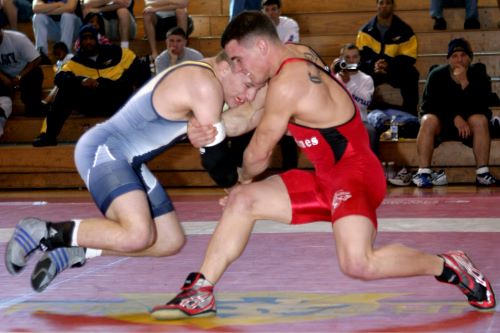
Wrestling is a grappling-based martial art focused on controlling an opponent through clinch-fighting, holds, throws, takedowns, and pins. It’s one of the best martial arts for self-defense for the following reasons.
1. Wrestlers dominate the standing grappling position
Wrestling is by far the best martial art for the standing grappling position, which is the position the overwhelming majority of people are in when an aggressor grabs them.
In the standing grappling position, wrestlers can dominate an aggressor in the clinch and tire them out. Wrestlers are also extremely well-versed in takedown defense so are able to stay on their feet, which increases the likelihood of being able to flee.
Even if an aggressor is a lot stronger and larger in size, a wrestler can execute one of many takedowns or throws to get the aggressor to the ground. As most self-defense scenarios happen on hard ground, taking down or throwing an aggressor to the ground is likely to end the scuffle.
Wrestlers are best in the standing grappling position because they relentlessly train it and focus on improving explosiveness, strength, aggression, speed, stability, agility, and perfect technique.
When on the ground, wrestlers know perfect positioning and how to control an opponent, as their aim is to pin them.
2. Wrestlers build size
Wrestling requires its practitioners to get bigger, stronger, and more explosive through heavy weightlifting – which deters many untrained aggressors who pick on smaller people.
3. Wrestling is a sport-based martial art with intense competition
Wrestling is often pressure tested through sparring, which makes it more transferable and easily used under stressful self-defense situations.
The high competition and repetitive nature of wrestling make it one of the best martial arts for self-defense because of the mental toughness and amazing cardiovascular endurance wrestlers build.
4. Wrestling matches are short and intense
Wrestling is focused on maximum intensity and explosiveness over a short period of 6 minutes, which is most representative of a real-life defense situation. If you can grapple and hold your own with an aggressor for a minute or two, they’re likely to disengage and flee the scene.
5. Wrestlers take less damage
Lastly, wrestling is great for self-defense because its focus on controlling an opponent means less damage taken and less damage given. You don’t want to abuse your power in a self-defense situation as it could lead to facing criminal charges.
Weaknesses
Having said that, the weakness of wrestling for self-defense is not teaching ground-and-pound (ground strikes), striking (standing), or submissions (Bjj). Once a wrestler has secured a dominant position, these offer the next step in neutralizing an aggressor.
4. Combat Sambo
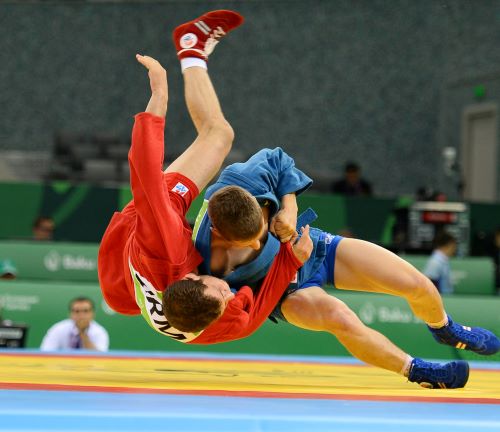
Sambo is a Russian martial art introduced uniquely for the Soviet police and special forces in the 1920s to improve their hand-to-hand fighting skills. Sambo is an acronym for samozashchita bez oruzhiya, which translates to self-defense without weapons.
Combat sambo as a martial art closely resembles MMA and is heavily influenced by many martial arts within the USSR. It includes striking, grappling, and submissions. Combat sambo is more effective for self-defense than sport sambo as it allows for chokehold submissions and striking.
Not only this, combat sambo is one of the best martial arts for self-defense for the following reasons.
1. Effective in the standing grappling position
Combat sambo is great in the standing grappling position, where it teaches clinch work, positioning, hand fighting, takedown defense, and takedown offense through sweeps, trips, hip tosses, and more.
In terms of grappling and submissions (especially standing grappling), combat sambo is heavily influenced by judo and wrestling and therefore focuses on throws and takedowns.
Throws are effective because once an aggressor is thrown to the ground, especially hard ground, they’re either injured or looking to escape.
2. Variety of attacks on the ground
If they can continue, combat samboists are well versed in advantageous positioning on the ground and the many judo and Bjj submissions.
As well as ground grappling and submissions, combat sambo also incorporates ground-and-pound. This gives samboists an extra option for both defense and attack on the ground, where it’s mostly used to set up submission attacks.
3. Focus on leg attacks
Unlike judo, combat sambo teaches leg attacks which are very useful for self-defense. Leg attacks can be used to take down an aggressor, which presents an opportunity to disengage and flee, or to submit them if the scuffle hits the ground.
On the ground, leg attack submissions are deadly, especially against an untrained aggressor. Some of the most effective leg submissions combat sambo teaches are kneebars, ankle locks, and heel hooks.
Leg-grabbing attacks also help with escaping from poor positions on the ground and quickly turning defense to offense.
4. Similar to MMA striking with illegal strikes incorporated
The striking in combat sambo is similar to MMA but also includes headbutts, groin shots, soccer kicks, punches, kicks, knees, and elbow strikes – all extremely useful tools in a self-defense situation. One headbutt to an aggressor’s nose or knee to the groin is always effective in hurting or stopping them.
As combat sambo is mostly grappling-based, striking is effective for weakening or tiring an aggressor before grappling is used to neutralize them. Striking also helps students understand distances and timing, and how to evade and defend against strikes before grappling is initiated.
5. Uniform makes skills transferable
Combat samboists wear a jacket and shorts uniform (Sambovka), which makes their techniques highly transferable to self-defense situations as they’re used to gripping, throwing, and taking down opponents by using their uniforms.
Overall, combat sambo is a great martial art for self-defense as it creates a well-rounded athlete who can defend multiple types of situations.
Weaknesses
Its weakness lies in its approach to learning smaller parts of each individual martial art, which makes an athlete less proficient in each.
Also, it’s not a global martial art and can be hard to find outside of the USSR. This means the level of training and competition outside of the USSR is also lower.
5. Judo
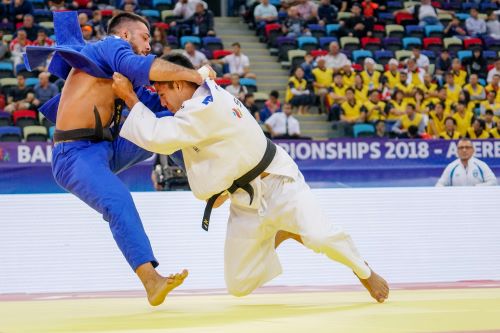
Judo is a grappling-based martial art focused on the ability to throw an opponent to the ground, immobilize them with a pin, or submit them with a lock or choke. With this in mind, judo is one of the best martial arts for self-defense for the following reasons.
1. Throws from the standing grappling position
In the standing grappling position, judokas are trained to grab an opponent and execute several dozens of explosive trips and throws from the standing position, as well as defend takedowns. This is great for self-defense as most fights start on the feet.
As judo focuses on explosive techniques to throw and trip opponents, it’s very useful for lighter people against heavier aggressors. Explosively throwing an aggressor to the hard ground will almost certainly end any scuffle, and it avoids the need for ground fighting.
2. Pins and submissions
However, once a judoka has an aggressor on the floor, they have expertise in pinning (like wrestling) and submitting with chokes and locks to the upper part of the body (judo doesn’t permit leg attacks).
Submissions and pinning can be used to hurt an aggressor or subdue them before fleeing.
3. Judogi makes judo techniques highly transferable
Judo’s use of a judogi (uniform) makes its throws, takedowns, and submissions very applicable to real-life self-defense situations as an aggressor’s clothing can be grabbed and used for many effective techniques. Judo has the most variety and number of throws and takedowns of any martial art.
4. Fast learning from any skill level
Founded in 1882, judo is one of the most popular competitive sport-based martial arts with a huge number of judokas worldwide. This makes learning and progressing very quick in judo as judokas can learn from each other and train with judokas at a similar skill level and above.
Judo is also highly competitive and incorporates frequent sparring sessions – which is well known for being one of the best ways to learn and translate skills over to self-defense situations.
Weaknesses
Judo is the lowest grappling-based martial on this list because it doesn’t incorporate leg attacks, which are extremely effective for takedowns and submissions.
It also doesn’t include any striking which is useful for understanding and keeping distance with defensive strikes, evasion, and blocking before grappling is initiated.
6. Muay Thai
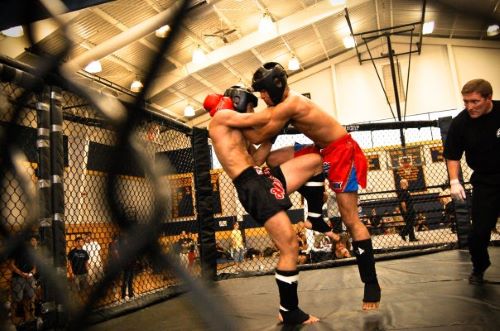
Muay Thai is known as the art of eight limbs because of its use of punches, elbows, knees, and kicks. Muay Thai focuses on stand-up striking but also includes clinches, sweeps, and throws from the standing position. Muay Thai is effective for self-defense for the following reasons.
1. Teaches evasion and how to block strikes
Muay Thai teaches an athlete to read and understand distance management and how to defend, evade, and block strikes. This is very useful for protecting yourself from an initial attack.
2. Variety of defensive strikes
Essential defensive strikes such as the oblique kick and the teep kick are also learned. They can be used while moving backward, to keep an opponent at bay, cause serious damage, or off-balance an aggressor.
All of these combined allow a muay Thai practitioner to reduce any damage taken and manage to flee, or quickly turn defense into attack if need be.
3. Muay Thai is a competitive sport-based martial art
Muay Thai incorporates a lot of sparring to pressure test and improve skills. Muay Thai competition and sparring also make a practitioner extremely athletic, strong, fit, and conditioned, because they’re essential to progression in the sport.
4. Muay Thai practitioners learn to be the aggressor and hurt an opponent.
Fighting aggressively with forward pressure, paired with elite striking technique, variety of strikes thrown, mental toughness, and insane cardiovascular endurance, most untrained aggressors will quickly learn they don’t want to be standing with someone trained in muay Thai.
5. Muay Thai clinch (standing grappling)
If an aggressor gets close enough to negate defensive or offensive striking, the muay Thai clinch comes in handy. In the clinch, muay Thai practitioners know how to hand and grip fight, strike with elbows and knees, sweep an opponent to the floor, or disengage by pushing an aggressor away.
Although muay Thai doesn’t teach any ground skills, once an aggressor has been struck a few times and swept to the floor, they’re unlikely to keep coming and the opportunity to flee will have presented.
Weaknesses
If an aggressor does get the fight to the ground, muay Thai practitioners are out of their depth. Muay Thai doesn’t teach takedown defense (specifically) or any ground fighting (no grappling or submissions), simply because it’s not part of the sport.
7. Lethwei
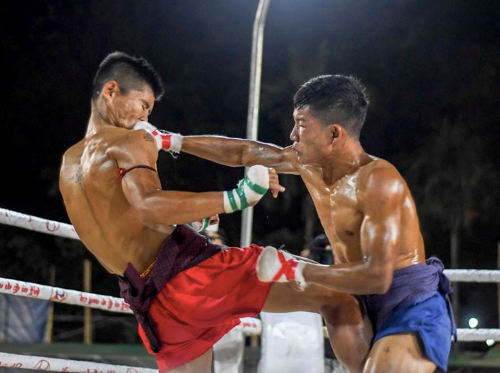
Lethwei is considered one of the most brutal martial arts in the world and is effective for self-defense for the following reasons.
1. As skillful as muay Thai with headbutts
Lethwei is very similar to muay Thai so it has all of the same benefits for self-defense. However, lethwei fighters can also headbutt, which is a great self-defense tool, especially during a clinch.
Once an aggressor has received an effectively delivered powerful headbutt, they’re unlikely to come back for more. The downside of this is that you’re going to hurt yourself in the process, but proper delivery minimizes this.
2. Lethwei is fought without gloves (just gauze and tape)
Lethwei fighters are more or less bare handed, so lethwei is more applicable to real-life self-defense situations as they’re fought without gloves.
Lethwei fighters are well versed in street fights because they’re not much different from the competition, whereas other martial arts such as boxing use big gloves and fighting without them can be offsetting and cause hesitation.
3. Lethwei is only won by knockout
Because of this, lethwei fighters are extremely durable, and mentally and physically tough.
They’re built to endure pain and fight until they knock out their opponent or get knocked out themselves. This kind of mental conditioning is a huge asset in self-defense situations as lethwei practitioners aren’t going to be phased, and won’t hesitate to defend themselves.
4. lethwei is a competitive sport-based martial art
The brutality of lethwei carries over to its sparring sessions, which are excellent for pressure testing, skill development, and confidence building.
Weaknesses
Much like muay Thai, lethwei doesn’t teach takedown defense or offense, nor any ground fighting.
What Is the Best Martial Art for Self-defense Against Multiple Aggressors?
The best martial art for self-defense against multiple aggressors is boxing because quick, technical, powerful punches and an ability to evade strikes and move around quickly on the feet is the only thing that works in this situation.
Trying to grapple against 2 or more aggressors will most likely leave you trapped and smothered as you’re attacked from different directions.
Boxing allows you to keep aggressors away and also inflict quick damage on each person. It’s the only martial art to be proven time and time again to work when outnumbered or at least give someone the best chance.
The Bottom Line
The best martial arts for self-defense are grappling-focused.
The best are MMA, Brazilian jiu-jitsu, and wrestling, where MMA is king because it combines wrestling, jiu-jitsu, and a striking discipline such as muay Thai, boxing, or lethwei, to create a well-rounded athlete without any holes in their self-defense.
Bjj is great for self-defense because of its focus on ground grappling involving positioning, locks, and chokes, how it works especially well for people of all weight sizes against a heavier aggressor, and its inclusion of standing grappling and takedowns.
Learning MMA requires a lot more time to get to an advanced level, whereas focusing solely on Bjj is more apt for most people as they can learn it faster through focus.
Lastly, wrestling is one of the best because of its focus on takedown defense, offensive takedowns, and clinch work to nullify and control an aggressor. It does however lack an offensive skill such as ground-and-pound or submissions, which is why MMA and Bjj are better for self-defense.




